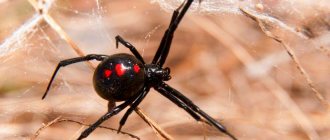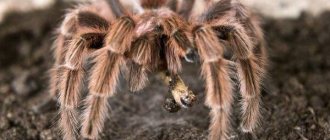Description and features
The body of this invertebrate creature has a head and cephalothorax with a hairy surface. This arachnid arthropod has as many as 8 eyes, with the help of which the tarantula can see in all directions. It is brown or black in color with red spots or stripes.
As for sizes, spiders are small, medium and large. On the American continent there are tarantulas with dimensions of 10 cm and a paw span of up to 30 cm. European inhabitants are slightly smaller. The average size of females is usually 2-3 cm. Males are a couple of cm larger.
Spiders have 8 legs and 2 fangs. These spiders have many enemies in nature. They provide food for foxes, coyotes, birds, lizards and snakes. All of them, as one, do not miss this opportunity to feast on a tarantula.
On the legs of spiders you can see claws that help them climb up hills. When in the wild, they can not only move on the ground, there are times when spiders need to climb a tree or some other object.
The hairy covering of the invertebrate's body, which is easily removed, serves as good protection for the spider during a possible enemy attack. When you touch it, the predator’s body begins to itch very much. An interesting feature of tarantulas is the silk thread with which they protect their possessions along with their eggs.
The spider has an amazing ability to pick up the slightest vibration emanating from the approach of enemies or prey. When a threat approaches, the tarantula hides. In cases of danger, they make sounds like the teeth of a comb vibrating. And the tarantula will wait in ambush for the victim heard by vibration until it approaches.
Female tarantulas eat the males after mating. Therefore, their life expectancy is always shorter. In offspring, on the contrary, the chances of survival double, thanks to the satiety of the female.
In general, if we talk about the survival rate of these spiders, it is at a very low level. More than half of these invertebrates die from predators in the first years of their existence.
Different people have different opinions about the appearance of spiders. For some, they are repulsive and disgusting, while others consider them original and damn attractive creatures.
In many countries, large tarantula spiders are among the most popular pets. For their use, special glass aquariums are used, and they are fed with animal food.
In the wild, these spiders prefer to live in deserts, tropical forests and grasslands. There are these creatures on almost all continents of the earth's planet. The only exception is Antarctica.
What a tarantula looks like - description
Like all arthropods, tarantulas have a body divided into two parts:
- Abdomen.
- Cephalothorax.
Its body is covered with small, fine hairs.
In the part of the upper cephalothorax of the tarantula there are eight eyes, four of them form a straight line, but the others form a trapezoid (they are larger). It is because of this eye structure that a poisonous spider can view its surroundings at 360 degrees. In addition to excellent vision, in search of a female (during the mating season) or in search of food, these arthropods use a well-developed sense of smell. The abdominal region contains the internal organs.
The body size of a tarantula can be from 2.5 to 10 centimeters. But the leg span reaches 30 centimeters. Males are much smaller in size and weight than females. The weight of a female can be 90 grams. Throughout its life, the tarantula spider can change its chitinous body covering several times. The eight powerful long legs of the tarantula spider are covered with fine bristles. When moving on a watery or loose surface, they increase the support area.
Powerful chelicerae (mandibles), due to the poisonous ducts that open on their jagged tops, serve not only as an oral appendage for such arachnids, but also as a means of defense and attack.
The tarantula spider has the following colors:
- Black.
- Gray.
- Brown.
- Light (very rare).
Such arachnids have well-developed sexual dimorphism. The differences between females and males are:
- Less developed forelimbs.
- Larger size.
These spiders lead a solitary lifestyle. Only during the mating season do they meet members of the opposite sex. At any time of the year, the males of such arachnids quarrel with each other. The exception is the hibernation period.
Tarantula lifestyle
Burrows of a large tarantula can be seen everywhere, most often the slopes of mountains are covered with them. The depth of the burrows varies, ranging from 50-60 cm deep. At the entrance to the tarantula's burrow you can see a small roller, which somewhat hides the entrance from prying eyes.
During the daytime, spiders prefer to hide in burrows. And when night falls, they go out hunting. Spiders protect their burrows from the winter cold using cobwebs and dry plants. All the walls in their home are shrouded in cobwebs. With its help, they are able to determine by vibration what is happening on the earth's surface.
As soon as the spring warmth is felt, spiders come to the surface and bask in the sun's rays.
Description of the South Russian tarantula
Araneomorphic spiders, which include the South Russian tarantula, are large in size, poisonous and beautiful. Looking at these creations of nature, it is impossible not to be surprised.
Appearance
The wolf spider's body consists of two parts: a large abdomen and a smaller cephalothorax. There are eight attentive ocelli on the cephalothorax. Four of them are located below and look straight ahead. Above them there are two large eyes, and two more on the sides, almost “on the back of the head,” providing an almost 360-degree view.
The body is covered with small black-brown hairs. The intensity of the color depends on the tarantula’s habitat; it can be very light or almost black. But the South Russian Mizgir definitely has a “trademark” - a black spot that is very similar to a skullcap.
The tarantula has four pairs of legs covered with fine hairs. These bristles increase the area of support when moving, and they also help to hear approaching prey.
The powerful mandibles with which spiders bite their prey have ducts for poison; they are a means of both attack and defense.
Males reach 27 mm in length, females – 30-32. At the same time, the record weight of a female Mizgir is up to 90 grams. On the abdomen there are arachnoid warts with a thick liquid, which, when frozen in air, turns into a strong network - a cobweb.
Image and life expectancy
Tarantulas are typical loners and only tolerate their relatives during the mating season. Males are quite tolerant of females, but they constantly quarrel with each other.
Each individual lives in its own home, a burrow up to 50 cm deep. They spend time in it during the day, from which they monitor approaching prey; a cobweb becomes a net for unwary insects, which seals the entrance to the burrow. Even when hungry, Mizgiri rarely go far from their habitat; in general, they prefer to catch food from home
Tarantulas are clever hunters. Having noticed prey or the shadow of an insect by the vibrations of the web, they make a powerful jump, grabbing and biting the victim, injecting poison and depriving the ability to resist.
Mizgiri rarely live longer than 3 years. The age of males is shorter than that of females. In winter they hibernate, carefully sealing the entrance to the burrow with grass and cobwebs. As soon as warm days arrive, suspended animation stops.
Poisonousness of Mizgir
Spider venom kills insects and can paralyze a mouse or a frog. A tarantula can cause acute pain to a person; swelling occurs at the site of the bite, and inflammation occupies a large area. Only an allergic reaction is very dangerous, so it is best to take antihistamines with you on hikes and excursions to places where tarantulas live.
The tarantula never attacks those who are significantly larger than it; humans are not interesting to it. But if he felt threatened and decided that he was being attacked, he would definitely bite.
Therefore, you should not wander barefoot through the sand near bodies of water where there are Mizgiri minks; you should carefully inspect your things and tent before going to bed in order to detect the hidden “predator” and resting place in time.
Reproduction and lifespan
Towards the end of summer, tarantulas become sexually mature. At these moments, males go out in search of females in the hope of mating. But these searches do not always end with the fulfillment of their desire. Sometimes the male may simply be eaten by the female. Therefore, in order to stay alive, they must not lose their vigilance for a single second.
When they meet, the males begin some kind of flirting. They actively vibrate their abdomen and move their forelimbs, giving a chance to understand their aspirations.
A female who is not against mating begins involuntary repetitions of all the movements of the male. After mating has taken place, it is advisable for the male to quickly retreat, otherwise he risks being eaten by a hungry spider.
The fertilized female has no choice but to hibernate in a well-walled hole. And only the arrival of spring makes it come to the surface.
In the abdomen exposed to the rays of the sun, offspring are formed in the form of eggs in the female. She lays already ripe eggs on the web she has prepared. The number of eggs depends on the species of tarantula. Their average number is about 400 pieces.
South Russian tarantula
The eggs are in the ripening stage. At the same time, the female builds a large cocoon, places her eggs there and attaches them to herself. The cocoon is on the spider until the first movements of the babies in it.
The female remains to gnaw the cocoon and help the offspring get out of it. Newborn spiders are in no hurry to leave their mother. They climb onto it and are placed there in several layers.
They live this way until the babies are able to eat on their own. After which the females have another mission - she needs to go around as much of the territory as possible and scatter her offspring over it. Tarantulas can live up to 20 years.
Nutrition
All insects and animals that are smaller than the tarantula are at risk of being eaten. They do not stray far from their burrow to hunt. They draw in their victim and are already having their meal at home. This happens somewhat unusually for them.
Spiders do not have teeth, so when they approach their victim, they pierce a hole in it, through which they inject their special agent to dissolve all the insides of the victim. And after that they suck out the dissolved contents without any problems.
What to do if bitten by a tarantula?
The toxicity of tarantulas depends on many factors - their species, gender, age, time of year. For example, in April spiders are not particularly active. They just woke up and are practically in no danger.
There are fewer spider bites, and they are not very toxic. In mid-May, spiders begin to lay their eggs and become more active. Aggression awakens in them and along with this toxicity increases.
The beginning of June is characterized by a 3-fold increase in toxicity. It is at this time that spiders mate and migrate. This is the most dangerous time. Only in September does the toxicity of tarantulas decrease.
In essence, the poison of these invertebrates does not pose a great danger to humans. The only exceptions are people prone to allergies and small children.
A tarantula bite may be accompanied by local pain, redness of the skin at the site of the bite, swelling, general malaise, drowsiness, and increased temperature. For some, these symptoms include dizziness and nausea.
Apulian tarantula
The bite site is under no circumstances cauterized. The bite should not be cut. This can lead to infection. Scratching is also contraindicated. You must first wash the bite with antibacterial or regular soap, followed by an antiseptic.
Applying cold can reduce the pain comparatively. A large amount of water will help quickly remove toxic substances. And taking antihistamines will relieve allergies. In case of sudden deterioration in health or bite of small children, it is better to call an ambulance.
Interesting facts about tarantulas
Although tarantulas inspire fear in many people, they are still peaceful creatures. You can find the largest of them, the size of which is no less than an average plate.
Directors instilled fear in people to a greater extent with their horror films starring tarantulas. The spiders were named after the city in Italy, Tarento. There were a lot of these creatures there. A variety of diseases have been attributed to their bites. Experts recommended smearing a spider bite with its own blood, which contains an antidote.
Popular message topics
- Wood
Wood is a fairly elastic material consisting of long fibers. The word wood speaks for itself of what this material consists of. Most often this includes the trunk, branches, roots of trees, which later pass - Leningrad About the Hero City The city of
Leningrad, now St. Petersburg, rightfully has a special degree of distinction in the USSR with the title of Hero City. The city on the Neva survived the terrible events of the Great Patriotic War. In 1941 The city was attacked by fascist invaders. There were no strength - The works of Anton Chekhov
A.P. Chekhov was born in 1860 in Taganrog. His father was a merchant, and a total of six children were born into the family. Anton Pavlovich knew the history of his ancestors well, mentioning the origin of his surname in a letter to the writer.
Kinds
The Brazilian jet black tarantula is considered one of the best pets. They are calm, impressive and obedient. In their popularity they are not inferior to any spider. They live for at least 20 years.
Brazilian jet black tarantula
They can decorate not only a zoo, a school living area, but also a home interior. Due to the fact that the venom of spiders, including these species, is toxic, it is not recommended to handle them with bare hands.
The South Russian tarantula is distinguished by its aggressiveness and speed. He does not forgive bad attitude towards himself. This type of spider is not recommended for people who know little about these creatures. They have increased jumping ability. To protect themselves and their home, they can jump 20 cm high.
In general, he is unpretentious and interesting. The Apulian tarantula is the most common in European countries. Its dimensions are slightly larger than those of the South Russian one. It is considered the most poisonous of the tarantulas.
Dzungarian tarantula
The South Russian or Dzungarian tarantula is common in the Caucasus, Central Asia, and southern Ukraine. Here it can be found in the steppes, in floodplain meadows near rivers.
When viewed from the front, the Dzungarian tarantula is quite cute and resembles a fairy-tale gnome. In a calm state, its front legs are lowered and a large streamlined head part of the body is visible, below is a transverse strip of short hairs, reminiscent of a short whisker brush; under it there is thick, longer hair, similar to a goatee, and above there are 2 large and under them 4 smaller eyes
Just a cartoon character! But if suddenly someone had the imprudence to disturb it, the picture changes radically: the spider raises its front legs high above its head, taking a threatening pose. Now he no longer looks like the sweetest creature
He's ready to attack!
The tarantula's vision is excellent. The spider has 8 eyes located at the cephalothorax end. 4 of them are shiny and clearly visible, and 4 are duller. The spider's 8 large legs, widely spaced in all directions, are covered with long black hairs. The poisonous apparatus of the tarantula is located on the sides of the anterior section of the cephalothorax and consists of two glands, the ducts of which end at the sharp ends of the strong jaws.








